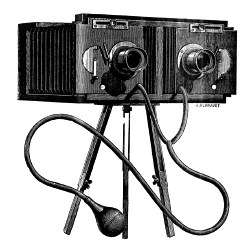La présence éventuelle d'une publicité ci-dessus est insérée par le routeur du "mailing-list" indépendamment de mes choix en compensation de la gratuité de son service Dr O Walusinski baillement.com baillement.info yawning.info

samedi 1er mars 2003 la lettre d'information du site baillement.com N°17 Si vous ne voyez pas les images, cliquez ici pour lire cette lettre dans votre navigateur. If you cannot see pictures below, to view the email in your web browser click here baillement.com est libre d'accès, base documentaire pour comprendre, chercher, travailler
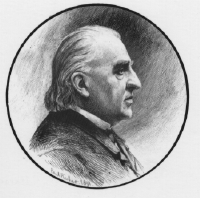
Contribution à l'étude des bâillements hystériques Nouvelle iconographie de La Salpêtière 
Jean Martin Charcot Portraits et biographie de 1894 Son cabinet photographique Son cabinet de consultation La leçon par M Breuillet 1887 - l'appareil photo de JM Charcot
-
In the brain neurosciences, where new discoveries are being made at a breathing rate, it is imperative to look back to appreciate just how far we have come. I am glad to present any of my personal books collection : the works of JM Charcot (1825-1893) (and its pupils) neurologist at the Salpêtrière in Paris, which also contributed much to the accumulating knowledge about hystery, Parkinson's disease, pathological yawn, etc... 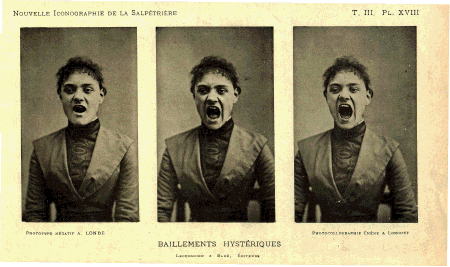
- JM Charcot, dès 1858, avait compris tout l'intérêt didactique de la récente découverte de la photographie. En 1890, parait le tome III de La Nouvelle Iconographie de La Salpêtrière, rédigé par ses disciples P Richer et GE Gilles de la Tourette qui rapportent pages 99 - 119, des "bâillements hystériques". Les descriptions des jeunes femmes atteintes, souvent épileptiques, avec des champs visuels amputés, des aménorrhées sans galactorrhée signalée, tendent à faire penser, avec les connaissances actuelles, qu'elles souffraient le plus souvent de tumeurs sellaires ou supra-sellaires et non d'hystérie dans l'acceptation actuelle de ce terme:
- Bâillements chez un épileptique Charles Féré (1852 -1907) Nouvelle Iconographie de La Salpêtrière 1888 (vol 1, n°4, p163-169)
- Les observations de la Thèse de R Trautmann en 1901
- Découvrez des illustrations inédites : le cabinet photographique du Prof Charcot à La Salpêtrière, son cabinet de consultation, une lettre manuscrite et de nombreux portraits du Maître. Ces documents proviennent de La Revue Encyclopédique, Libraire Larousse, 4° année, N°78, 1 mars 1894. La liste des écrits de JM Charcot établie par Levillain en 1894.
- Voir le célèbre tableau : Une leçon de Charcot à La Salpêtrière en 1887, tableau de M Brouillet (musée de Lyon)
- Lire : Aux origines du cerveau moderne: localisations, langage, mémoire dans l'oeuvre de Charcot Jacques Gasser Fayard ed 1995
- Lire : La photographie médicale 1839-1881 Chistian Régnier La Revue du Praticien 1995; t 45; p 808-812
- Lire : Hystérie : L'iconographie de La Salpêtrière artistes et modèles M Corcos P Clervoy La Revue du Praticien 1995; t 45; p 1205-1207
- Lire : La longue marche d'Etienne-Jules Marey La Revue du Praticien 2002; t 52; p705-707
- Lire : nombreux articles pour le centenaire de la mort de JM Charcot dans La Revue de Neurologie (Paris) 1994; N°150
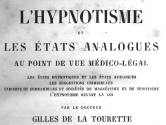
Une regrettable habitude anglo-saxone fait penser qu'il s'appelait de la Tourette. Le nom est Gilles de la Tourette au complet, prénomé Georges ! L'eesentiel des documents présentés proviennent de ma collection bibliophilique personnelle L'excès de bâillements :un équivalent de tics et /ou de troubles obsessionels et compulsifs (tocs) Tics, Maladie de Gilles de la Tourette, Troubles obsessionnels et compulsifs Adult onset tic disorders Chouinard S, Ford B J Neurol Neurosurg Psychiatry 2000; 68; 738-743 Virgilio Evidente Neurology january 1999, 52 p428 lire le numéro spécial de La Revue de Neurologie 1986, 142; 11; consacré à la maladie de Gilles de la Tourette Semiology, nosolgy and criteria for tic disorders E & A Shapiro Gilles de la Tourette and his syndrome by serendipity H Stevens American J Psychiatry 1971; 128; 4; 489-492 Tourette Disorder S Zinner Pediatrics in Review 2000;vol 21; 11; 372-382 A functional neuroanatomy of tics in Tourette syndrome E Stern, D Silbersweig Arch Gene Psychiatry Aug 2000; vol 57; p741-748 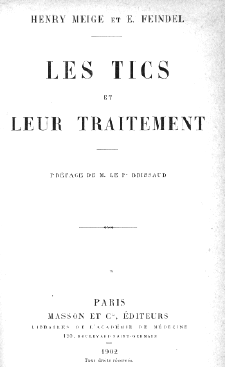
AMADYS l'association des malades atteints de dystonie www.blepharospasm.org
Une nouvelle page du site est consacrée àGeorges Edouard Gilles de la Tourette rapporteur des observations des bâillements hystériques dans la Nouvelle Iconographie de La Salpêtrière 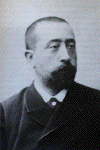
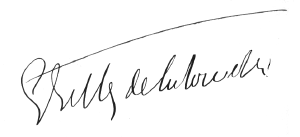
- Cet autographe provient d'une dédicace en tête de sa thèse "Etudes cliniques et physiologiques sur la marche " Delahaye et Lecrosnier Ed 1886
- Georges Albert Edouard Brutus Gilles de la Tourette (1857-1904), one of Charcot's favourite pupils and his self-appointed amanuensis made several valuable contributions to medicine and literature. His most substantial achievements were in the study of hysteria and the medico-legal ramifications of hypnotism, but he was also a competent neuropsychiatrist with a particular interest in therapeutics. He was a dynamic, passionately outspoken man whose prodigious literary output reflected his own restless compulsions as well as the interests of his beloved chiefs Brouardel and Charcot. His love of Loudun, his ancestral home strongly influenced his subject matter which included a biography of Theophraste Renaudot and with his colleague Gabriel Legué a perceptive analysis of Sceur Jeanne des Anges account of her hysterical illness induced by her unrequited love for the Loudun priest Urbain Grandier. In 1893 shortly after the tragic death of his young son and of his mentor Charcot, Gilles de la Tourette was shot by a deluded woman who had been a patient at the Salpêtrière (See a picture from the Pays Illustré 1893). Her claims that she had been hypnotised by Gilles de la Tourette against her will causing her to lose her sanity bore a macabre resemblance to the accusation of Sœur Jeanne des Anges against Grandier. The bizarre episode became a « procès célèbre » seeming superficially to vindicate the Nancy School's views that criminal suggestion was possible under hypnotism, a view Gilles de la Tourette had vehemently rejected. Despite his colourful life and varied achievements only an incomplete biographical account by his friend Paul le Gendre, a few informative orbituaries and some caustic sketches by Leon Daudet exist. AJ Lees
- Georges Albert Édouard Brutus Gilles de la Tourette (1857-1904), un des élèves favoris de Charcot, a fourni une contribution intéressante à la médecine et à la littérature. Ses écrits ont été essentiellement consacrés à l'étude de l'hystérie et aux conséquences médico-légales de l'hypnotisme. ("L'hypnotisme et les états analogues" qui influença S Freund, auditeur de Charcot à l'époque) Pourtant, c'était aussi un neuro-psychiatre compétent ayant un intérêt particulier pour la thérapeutique. Chez cet homme dynamique et passionné, la production littéraire abondante résultait probablement de l'hyperactivité incessante, aussi bien que de l'intérêt de ses patrons bien-aimés, Brouardel et Charcot. Son amour pour Loudun, son lieu d'origine, a largement influencé son œuvre qui comprend une biographie de Théophraste Renaudot et, avec son collègue Gabriel Legué, une analyse du tableau hystérique de Sœur Jeanne des Anges, et de son amour non récompensé pour le prêtre Urbain Grandier. En 1893, peu après la fin tragique de son jeune fils et de son mentor Charcot, une de ses malades de la Salpêtrière lui tira une balle de révolver.(une gravure du Pays Illustré 1893 relatant la tentative de meurtre). Il y avait une macabre ressemblance entre les déclarations de cette femme qui prétendait avoir été hypnotisée par Gilles de la Tourette contre son gré et l'accusation de Sœur Jeanne des Anges contre Grandier. Il s'ensuivit un procès, resté célèbre, qui a été interprété, notamment par l'École de Nancy, comme une criminalité déclenchée par hypnotisme, une vue que Gilles de la Tourette rejeta de manière véhémente. En dépit de son existence colorée et de son œuvre variée, les données biographiques sur Gilles de la Tourette sont pauvres. Son ami, Paul Le Gendre a fourni quelques aperçus malheureusement incomplets de sa vie ; quelques histoires caustiques ont été rapportées par Léon Daudet. AJ Lees.
- La maladie des tics convulsifs Gilles de la Tourette La Semaine Médicale 1899
- maintenant sur le site à télécharger en format pdf
- La description, entendue de grands bâilleurs, montre des analogies frappantes avec les tiqueurs: irrésistibles, volontaires et involontaires, maitrisables un moment par un effort de volonté mais procurant un immense plaisir lors de leur exécution libératoire. Ils décrivent une impression de besoin, et de satisfaction secondaire, une détente, une mini-extase brève, survenant à la fin de la salve de bâillements, comme en ressentent les compulsifs après la réalisation "just right" de leur compulsion.
- En complément d'une observation originale présentée sur le site, voici les observations rapportées par S Chouinard et B Ford de Montreal et Virgilio Evidente de Rome (Neurology january 1999, 52 p428)
- Sensory tics : The majority of patients experience tics as involuntary and do not have a preceding, sensory feeling. Another group of patients have a different pattern which we refer to as sensory tics. Sensory tics are defined as recurrent, involuntary, somatic sensations in joints, bones, muscles, or other parts of the body. The sensation, characterized as a heaviness, lightness, emptiness, tickle, coldness, hotness or other sensation, is experienced as dysphoric and causes the patient to execute a voluntary movement to relieve the dysphoria. The movements, which utilize voluntary muscles in any part of the body, are intentional or voluntary, usually tonic squeezes, stretches, yawn, tightening of muscles or other movements lasting one second or more. The dysphoric sensation is relieved only temporarily by the movement and recurs persistently. Some patients do not have a precipitating sensation, but describe a need to feel or squeeze the muscle, even to the point of pain. They are voluntary responses to a sensory stimulus in the larynx or throat, frequently in the form of yawning, humming, gurgling or « mm » sounds.
- In complemntarity of an observation of the website, you can read the work of S Chouinard et B Ford of Montreal about obsessive compulsive disorder and yawning (and see also Virgilio Evidente Neurology january 1999, 52 p428)
- A 46 year old man with obsessive compulsive disorder was referred by his psychiatrist because of frequent yawning spells. It soon became apparent that his movements, superficially resembling yawning, were different from his normal yawning. The yawning movements were preceded by a sensation of drowning or suffocation that could only be relieved if the yawning movement was "just right: I need that good breath". The yawning was temporarily suppressible, and did not occur if the patient was distracted. The yawning could be substituted for by a sigh, which also abolished the sensation of asphyxia. Diazepam helped to reduce the movement. There was history of previous tics, and the family history was notable for Parkinson's disease. As a child, the patient had obsessive rituals that did not impair him.
- A Functional Neuroanatomy of Tics in Tourette Syndrome Emily Stern, David A Silbersweig and all
- Arch Gene Psychiatry Aug 2000; vol 57; p741-748
- « Aberrant activity in the interrelated sensorimotor, language, executive, and paralimbic circuits identified in this study may account for the initiation and execution of diverse motor and vocal behaviors that characterize tics in TS, as well as for the urges that often accompany them. »
- Henry Meige (1866-1940) In 1910, H Meige described the movement disorder more recently termed "Brueghel's syndrome" or oral mandibular dystonia and blepharospasm .H Meige was born in Moulin, France. His medical training was in Paris, and he was one of Charcot's last interns. Unlike his contemporaries, Babinski and Gilles de la Tourette, Meige eschewed the controversial, demanding "concours" or publie competitions for academic tenure at the Faculty of Medicine. Instead, he dedicated himself to research in clinical neurology and art. His work with Brissaud led him to focus on involuntary movements. Les Tics and leur Traitment, an enduring work by Meige and Feindel, was later translated by Wilson. Other writings of Meige dealt with hysteria, neurasthenia, gigantism, and the autonomic changes associated with nerve injuries. Guided by Richer, his artistic capacities developed, and these remain well displayed in the Nouvelle Iconographie de la Salpêtrière . Meige succeeded Richer as professor of anatomy at the Ecole des Beaux-Arts
- Henry Meige (1866-1940) connu pour avoir attaché son nom à la dystonie oro-mandibulaire et au blépharospasme , est né à Moulins (Allier). Formé à la faculté de médecine de Paris, il fut l'un des derniers internes du Prof Charcot. Contemporain de Babinski et Gilles de la Tourette, H Meige ne suivit pas la voie des concours, déjà controversée, mais se dirigea vers la recherche en neurologie sans négliger sa passion pour les Arts. Associé à Brissaud, il se consacra à l'étude des mouvements anormaux et publia en 1902 avec E Feindel (couverture ci-contre) le premier livre jamais écrit sur les tics et leur traitement. Ses autres travaux seront consacrés à l'hystérie, la neurasthénie, le gigantisme et les modifications du système nerveux végétatif secondaires à des lésions nerveuses périphériques (algodystrophie). Guidé par Richer, il développa ses aptitudes artistiques qu'il mit au service de l'édition de la Nouvelle Iconographie de la Salpêtrière . Meige succèda à Richer comme professeur d'anatomie à l'Ecole des Beaux-Arts.
Blepharospasm-oromandibular dystonia syndrom CD Marsden Le bâilleur, Yawning Man or De Gaper Pieter Brueghel the Elder Paroxysmal kinesigenic dystonia associated with a medullary lesion Riley DE Meige, H. Les convulsions de la face, une forme clinique de convulsion faciale, bilatérale et médiane Revue Neurologique (Paris), (1910) 20, 43 7-443
Physiologic variations of the internal jugular vein surface, role of the omohyoid muscle, a preliminary echographic study Patra PCerebrospinal fluid flow; physiology of respiration-related pulsations Schroth G The formation and circulation of cerebrospinal fluid inside the cat brain ventricles: a fact or an illusion? Oreskovic D voir le site de neuranatomie du Dr Hasboun 
-
L'échographie et le doppler veineux permettent d'étudier la physiologie de la circulation veineuse jugulaire, reflet indirect, de la circulation des sinus veineux intra-craniens. Ce travail montre l'effet de la contraction des muscles omo-hyoïdiens au cours du bâillement, confirmant le rôle de compression des veines jugulaires par les muscles omo-hyoïdiens, et le retentissement hémodynamique veineux intracérébral du bâillement. Cette augmentation de pression veineuse a été rendue responsable de l'influence du bâillement sur la circulation du liquide céphalo-rachidien LCR. Des travaux récents contestent, en partie, cette physiologie, en impliquant l'action conjuguée de forces osmotique et hydrostatique dans la circulation du LCR. Tous ces travaux sont maintenant présentés sur le site. - The action of the omohyoid muscle on the hemodynamics of the internal jugular vein is controversial. For some authors, contraction of this muscle, by tightening the cervical fascia, promotes jugular venous return. For others, contraction of this muscle compresses the jugular vein in its cervical path. With this latter point in mind, the hemodynamics of the intemal jugularvein have been studied in its cervical path by echography in 10 healthy volunteers. One hundred twenty measurements of the venous surface were made at rest, with the mouth open and during deep inspiration. In the last 2 situations, evidence of a significant increase in the venous surface was found above the omohyoid muscle. These data confirm the role of compression of the vein by the omohyoid muscle, leading to modifications in intracerebral venous hemodynamics, which can be affected during the yawn.
- It is very well known that the increase of blood osmolality can decrease the CSF (intracranial) pressure, simply by extraction of fluid from nervous tissue. Experimental results clearly revealed that the increase in CSF osmolality will subsequently lead to the increase of the CSF volume inside the brain ventricles. This drives to a conclusion that the osmolality represents one of the major determinants of fluid exchange in intracranial pressure. It seems that the control of the CSF volume is under the influence of hydrostatic and osmotic forces between the CSF system and the surrounding tissue and that the CSF volume will be changed, depending on the prevalence of those forces, caused by (patho)physiological reasons inside or outside the CSF system. Anyhow, the results presented in this article call for a new approach to the physiology and pathology of CSF and we feel that time has come to re-evaluate the classical hypothesis of the CSF hydrodynamics to abandon this hypothesis as the traditional framework of thinking.
-
John N Fink de Brookline a publié, en 2001, dans la Revue Neurology une observation d'une jeune patiente de 24 ans, atteinte d'une forme neurologique de lupus aigu disséminé (LED), avec disparition de l'éternuement et du bâillement associée à des crises de hoquets lors des repas. Il présente l'imagerie du tronc cérébral en RMN situant l'origine des lésions au niveau du tronc cérébral. A voir sur le site. - John N Fink of Brookline report in Neurology (2001) the observation of a women with inability to sneeze or yawn and hiccups after meal. She had a history of venous thrombosis and a family history of systemic lupus erythematosus (SLE). MRI revealed evidence of extensive brainstem demyelination. Now on the site.
Localization of the "sneeze center" Fink JN Neurology 2001; 56(1); 138 Localization of the "sneeze center" Suranyi L Neurology 2001; 57(1); 161 voir aussi : Nonaka S, Unno T, Ohta Y, Mori S Sneeze-evoking region within the brainstem. Brain Res 1990; 511; 265Ð270 Hersch M Loss of ability to sneeze in lateral medullary syndrome. Neurology 2000; 54; 520Ð521 Grant AC, Roter EP Circadian sneezing Neurology 3-1994; 44; 369-375
-
Out of Mind: Varieties of Unconscious Processes Edited by Beatrice de Gelder, Edward de Haan and Charles Heywood Oxford University Press, 2002 - In Out of Mind some of the leading cognitive neuroscientists of the day explain what we know about unconscious processing; the book presents a state of the art account of what we now know about the unconscious, providing a fascinating account for researchers in psychology, cognitive neuroscience, and philosophy. A rational analysis of the relevant literature in the field of the implicit/explicit dimension is presented and perhaps the most important conclusion is that research from the field of healthy individuals, animals and brain damaged individuals does not always yield the same conclusions. Given the importance of clarifying exactly how unconscious processing differs from its conscious counterpart, this cross discipline research may provide a very reliable method of inquiry and perhaps, in the future, understood the "contagiousness" of yawning.
- Dans cet ouvrage paru en 2002, B de Gelder et coll, neuroscientistes et chercheurs réputés d'autres branches, dressent le tableau des connaissances actuelles des mécanismes neurophysiologiques à la base de l'inconscient. Une analyse rigoureuse des champs implicites et explicites de l'activité cognitive, batie à partir d'explorations de sujets sains, d'animaux et de malades, clarifie un domaine méconnu des recherches actuelles en neurosciences, distinguant les différences des processus d'élaboration du conscient et de l'inconscient. C'est la voie pour comprendre, un jour futur, les mécanismes neurophysiologiques sous-tendant la "contagion" du bâillement.
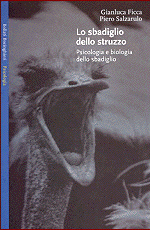
Gianluca Ficca & Piero Salzarulo "Lo Sbadiglio Dello Struzzo" , Bollati Boringhieri, Torino, 2002
-
An Italian psychiatrist and sleep researcher Giancula Ficca and Prof. Piero Salzarulo, in Italy, have just released a book entirely devoted to yawning. The book is in Italian and its title is "Lo sbadiglio dello struzzo" (which means "The yawn of the ostrich"): all the main aspects of yawning, including medicine , psychology, antropology, ethology, literature are deal. - Gianluca Ficca, MD, PhD Department of Psychology Second University of Naples Via Vivaldi 43 ; 81100 - Caserta - Italy
- Un psychiatre italien, impliqué dans la recherche en hypnologie, Giancula Ficca, associé au Prof Piero Sazarulo a publié en 2002, en italien, une monographie consacrée au bâillement qu'ils ont intitulée : "le bâillement de l'autruche". Ils passent en revue de nombreux aspects du bâillement de l'antropologie, l'éthologie juqu'à la médecine et la littérature.
- Voici la liste des derniers travaux, orientés vers l'hypnologie pédiatrique, publiés par cette équipe:
- Preterm infants prefer to be awake at night Giganti F, Fagioli I, Ficca G, Cioni G, Salzarulo P.Neurosci Lett 2001 Oct 12;312(1):55-7
- Yawning and behavioral states in premature infants Giganti F, Hayes MJ, Akilesh MR, Salzarulo P Dev Psychobiol 2002; 41(3); 289-96
- Awakening from sleep T Akerstedt, M Billiard, M Bonnet, G Ficca, L Garma, M Mariotti, P Salzarulo, H Schulz Sleep Medicine Reviews July 2002; Vol 6; n°4,; 267-286
- Morning recall of verbal material depends on prior sleep organization Ficca G, P Lombardo Behav Brain Res 2000; 112(1-2); 159-63
- Sleep organization in the first year of life: developmental trends in the quiet sleep-paradoxical sleep cycl Ficca G, I Fagioli J Sleep Res 2000; 9(1); 1-4
- Polygraphic investigation of 24-h waking distribution in infants Giganti F, I Fagioli Physiol Behav 2001; 73(4); 621-4
- Activity patterns assessed throughout 24-hour recordings in preterm and near term infants Giganti F, G Cioni Dev Psychobiol 2001; 38(2); 133-42
- Time course of EEG background activity level before spontaneous awakening in infants Zampi C, I Fagioli J Sleep Res 2002; 11(4); 283-7
-
Autres documents mis en ligne ce mois-ci :
- A Hippocampal oxytocin mediates apomorphine-induced penile erection and yawning Melis MR
- The effects of pre and post-operative procedures on physiostigmine and apomorphine induced yawing in rats Bourson A
- Effects of ageing on the behavioural responses to dopamine agonists: decreased yawning and locomotion, but increased stereotypy Stoessl AJ
- Threshold for behavioral response to testosterone in old castrated male rhesus macaques Phoenix C
- Variation of behavioral and physiological variables in children attending kindergarten and primary school
- Association of spontaneous and dopaminergic-induceed yawning and penile erections in the rat Holmgren B
- Stretching and yawning: a role of glutamate Lanthorn TH, Isaacson RL
- Do autoreceptors mediate dopamine agonist-induced yawning and suppression of exploration ? Stahle L
- The problem of yawning in reptiles Luttenberger F
- Frequencies and contexts of gape yawn displays of free-ranging patas monkeys Zucker EL
- Prolactin-induced yawning behavior requires an intact nigro-striatal dopamine system Laping NJ, Ramirez VD
- Potentiation by serotonergic inhibition of yawning induced by dopamine receptor agonists in rats Matsumoto S
- Serotonergic and dopaminergic effects on yawning in the cat Marini JL
- Schémas des differents systèmes des neuuomédiateurs cérébraux
- Yawning shows we're just big babies N Boyce
Résultats du sondage au 27 février 2003
-
Nombre de questionnaires remplis : 749 - Combien de fois bâillez-vous par jour ? <5 = 27,4%.. 5-10 = 25,8%.. 10-15 = 14;6%.. 15-20 = 9,3%.. >20 = 23%
- Ressentez-vous des baillements excessifs ?
- 76,1% = non, tant
mieux
25,5% = oui et je ne sais pas pouquoi - 6% = oui et je prends des antidépresseurs
- 1,3% = oui et je prends
des anti-épileptiques
4,8% = oui et je prends d'autres médicaments
2,8% = oui et j 'ai des troubles neurologiques
2,3% = oui et j 'ai des troubles hormonaux
3.3% = oui et j 'ai des tics moteurs
2% = oui et j 'ai des tocs - déclenchez-vous facilement le bâillement d'autrui ? 73,8%
- êtes-vous sensible au bâillement d'autrui ? 74,6%
-
«Philosphy is to science what alcohol is to sex : it may stir the imagination, fire the passions, and get the process underway, but the actuel implementation may be flawes, and the result may come up short»
Robert Provine
baillement.combaillement.info yawning.info écrits et réalisés par le Dr Walusinski
Voici le nombre d'abonnés à cette lettre : courriel à adresser lire les lettres précédentes d'information du site
